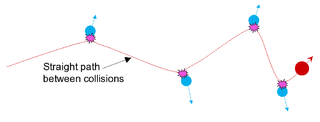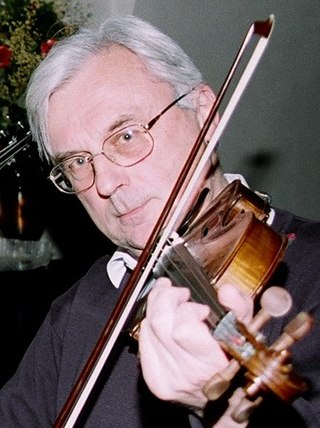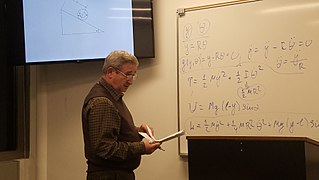
Spectroscopy is the field of study that measures and interprets the electromagnetic spectra that result from the interaction between electromagnetic radiation and matter as a function of the wavelength or frequency of the radiation. Matter waves and acoustic waves can also be considered forms of radiative energy, and recently gravitational waves have been associated with a spectral signature in the context of the Laser Interferometer Gravitational-Wave Observatory (LIGO).
Atomic, molecular, and optical physics (AMO) is the study of matter–matter and light–matter interactions, at the scale of one or a few atoms and energy scales around several electron volts. The three areas are closely interrelated. AMO theory includes classical, semi-classical and quantum treatments. Typically, the theory and applications of emission, absorption, scattering of electromagnetic radiation (light) from excited atoms and molecules, analysis of spectroscopy, generation of lasers and masers, and the optical properties of matter in general, fall into these categories.
Tennessine is a synthetic chemical element with the symbol Ts and atomic number 117. It is the second-heaviest known element and the penultimate element of the 7th period of the periodic table.
In quantum chemistry and molecular physics, the Born–Oppenheimer (BO) approximation is the best-known mathematical approximation in molecular dynamics. Specifically, it is the assumption that the wave functions of atomic nuclei and electrons in a molecule can be treated separately, based on the fact that the nuclei are much heavier than the electrons. Due to the larger relative mass of a nucleus compared to an electron, the coordinates of the nuclei in a system are approximated as fixed, while the coordinates of the electrons are dynamic. The approach is named after Max Born and his 23-year-old graduate student J. Robert Oppenheimer, the latter of whom proposed it in 1927 during a period of intense ferment in the development of quantum mechanics.
In chemistry, molecular orbital theory is a method for describing the electronic structure of molecules using quantum mechanics. It was proposed early in the 20th century.

Molecular physics is the study of the physical properties of molecules and molecular dynamics. The field overlaps significantly with physical chemistry, chemical physics, and quantum chemistry. It is often considered as a sub-field of atomic, molecular, and optical physics. Research groups studying molecular physics are typically designated as one of these other fields. Molecular physics addresses phenomena due to both molecular structure and individual atomic processes within molecules. Like atomic physics, it relies on a combination of classical and quantum mechanics to describe interactions between electromagnetic radiation and matter. Experiments in the field often rely heavily on techniques borrowed from atomic physics, such as spectroscopy and scattering.
A shape resonance is a metastable state in which an electron is trapped due to the shape of a potential barrier. Altunata describes a state as being a shape resonance if, "the internal state of the system remains unchanged upon disintegration of the quasi-bound level." A more general discussion of resonances and their taxonomies in molecular system can be found in the review article by Schulz,; for the discovery of the Fano resonance line-shape and for the Majorana pioneering work in this field by Antonio Bianconi; and for a mathematical review by Combes et al.
Superheavy elements, also known as transactinide elements, transactinides, or super-heavy elements, are the chemical elements with atomic number greater than 103. The superheavy elements are those beyond the actinides in the periodic table; the last actinide is lawrencium. By definition, superheavy elements are also transuranium elements, i.e., having atomic numbers greater than that of uranium (92). Depending on the definition of group 3 adopted by authors, lawrencium may also be included to complete the 6d series.

Ian Philip Grant, DPhil; FRS; CMath; FIMA, FRAS, FInstP is a British mathematical physicist. He is Emeritus Professor of Mathematical Physics at the University of Oxford and was elected a fellow of the Royal Society in 1992. He is a pioneer in the field of computational physics and is internationally recognised as the principal author of GRASP, the General Relativistic Atomic Structure Program.

In nuclear and materials physics, stopping power is the retarding force acting on charged particles, typically alpha and beta particles, due to interaction with matter, resulting in loss of particle kinetic energy. Its application is important in areas such as radiation protection, ion implantation and nuclear medicine.
The term R-matrix has several meanings, depending on the field of study.
In physics, Mott scattering also referred to as spin-coupling inelastic Coulomb scattering, is the separation of the two spin states of an electron beam by scattering the beam off the Coulomb field of heavy atoms. It is named after Nevill Francis Mott, who first developed the theory. It is mostly used to measure the spin polarization of an electron beam.
Triatomic hydrogen or H3 is an unstable triatomic molecule containing only hydrogen. Since this molecule contains only three atoms of hydrogen it is the simplest triatomic molecule and it is relatively simple to numerically solve the quantum mechanics description of the particles. Being unstable the molecule breaks up in under a millionth of a second. Its fleeting lifetime makes it rare, but it is quite commonly formed and destroyed in the universe thanks to the commonness of the trihydrogen cation. The infrared spectrum of H3 due to vibration and rotation is very similar to that of the ion, H+
3. In the early universe this ability to emit infrared light allowed the primordial hydrogen and helium gas to cool down so as to form stars.

In condensed-matter physics, the binary collision approximation (BCA) is a heuristic used to more efficiently simulate the penetration depth and defect production by energetic ions in solids. In the method, the ion is approximated to travel through a material by experiencing a sequence of independent binary collisions with sample atoms (nuclei). Between the collisions, the ion is assumed to travel in a straight path, experiencing electronic stopping power, but losing no energy in collisions with nuclei.
Quantemol Ltd is based in University College London initiated by Professor Jonathan Tennyson FRS and Dr. Daniel Brown in 2004. The company initially developed a unique software tool, Quantemol-N, which provides full accessibility to the highly sophisticated UK molecular R-matrix codes, used to model electron polyatomic molecule interactions. Since then Quantemol has widened to further types of simulation, with plasmas and industrial plasma tools, in Quantemol-VT in 2013 and launched in 2016 a sustainable database Quantemol-DB, representing the chemical and radiative transport properties of a wide range of plasmas.

Prof. RNDr. Jiří Horáček, DrSc. is a Czech theoretical physicist, professor at Charles University in Prague, where he works at the Institute of Theoretical Physics, which is a part of the Faculty of Mathematics and Physics. He was the director of the Institute in 2003–2011. He works in the field of theoretical atomic and molecular physics with a special focus on numerical solutions to integral and differential equations of scattering theory and on numerical analytic continuation methods localizing the poles of scattering quantities related to resonances.
Unbiunium, also known as eka-actinium or element 121, is the hypothetical chemical element with symbol Ubu and atomic number 121. Unbiunium and Ubu are the temporary systematic IUPAC name and symbol respectively, which are used until the element is discovered, confirmed, and a permanent name is decided upon. In the periodic table of the elements, it is expected to be the first of the superactinides, and the third element in the eighth period. It has attracted attention because of some predictions that it may be in the island of stability. It is also likely to be the first of a new g-block of elements.

Oleg Ivanovich Zatsarinny (1953-2021) was a Ukrainian-American theoretical physicist noted for his contributions to all aspects of research related to electron scattering in atoms. He was awarded the status of Fellow in the American Physical Society, after he was nominated by his Division of Atomic, Molecular & Optical Physics in 2008, for "the development of the B-Spline R-matrix method with non-orthogonal orbital sets for atomic structure calculations of exceptional accuracy and benchmark calculations for excitation and ionization of complex atoms and ions by photon and electron impact."

The Collaborative Computational Projects (CCP) group was responsible for the development of CCPForge, which is a software development tool produced through collaborations by the CCP community. CCPs allow experts in computational research to come together and develop scientific software which can be applied to numerous research fields. It is used as a tool in many research and development areas, and hosts a variety of projects. Every CCP project is the result of years of valuable work by computational researchers.

Collaborative Computational Project Q (CCPQ) was developed in order to provide software which uses theoretical techniques to catalogue collisions between electrons, positrons or photons and atomic/molecular targets. The 'Q' stands for quantum dynamics. This project is accessible via the CCPForge website, which contains numerous other projects such as CCP2 and CCP4. The scope has increased to include atoms and molecules in strong laser fields, low-energy interactions of antihydrogen with small atoms and molecules, cold atoms, Bose–Einstein condensates and optical lattices. CCPQ gives essential information on the reactivity of various molecules, and contains two community codes R-matrix suite and MCTDH wavepacket dynamics.







